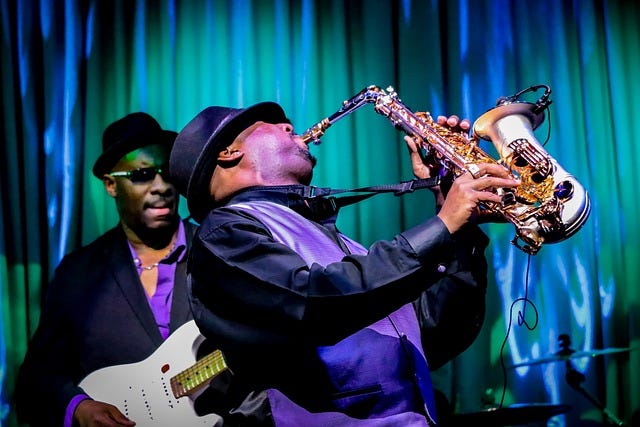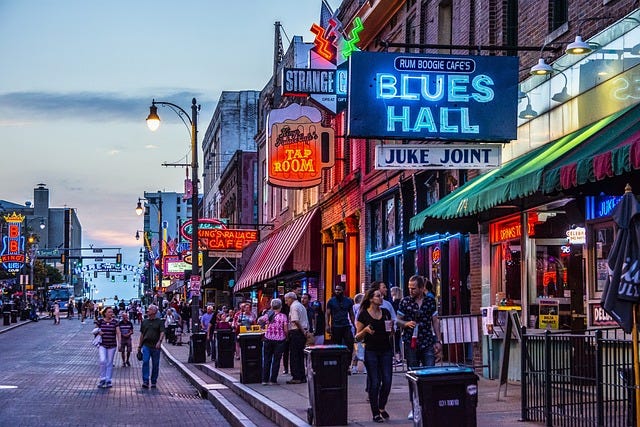B.B.King
Everyday everyday I have the blues
Ooh everyday, everyday I have the blues
When you see me worryin' baby, yeah it's you I hate to lose
Whoa nobody loves me, nobody seems to care
Whoa nobody loves me, nobody seems to care
Well worries and trouble darling,
Babe you know I've had my share
Everyday, everyday, everyday, everyday
Everyday, everyday I have the blues
When you see me worryin' baby, yeah it's you I hate to lose
Whoa nobody loves me, nobody seems to care
Whoa nobody loves me, nobody seems to care
Well worries and trouble darling, babe you now know I've had my share.
What is the Blues?
But rather than sink into despair, many Black Americans have leaned on forms of Black cultural expression—call it the blues—to find a way out of no way.—Eric Herschthal, The New Republic, 23 Mar. 20233
Let the blues tell it, and Black music ain’t all that far off from letting the Church tell it, which means singling out the seekers of salvation arriving at their altars to plead or confess.—Hanif Abdurraqib, The New Yorker, 22 Mar. 2023 On
One of the most challenging sets to pull off was Beale Street, a roughly two-mile stretch of downtown Memphis that became vibrant of the most challenging sets to pull off was Beale Street, that became a vibrant locus for Black musical culture—the blues specifically—and a source of inspiration for a young Elvis Presley.—Anna Fixsen, ELLE Decor, 1 Mar. 2023
Downtown Memphis became a vibrant locus for Black musical culture—the blues specifically—and a source of inspiration that intrigued Handy asked what the line meant. It turned out that the tracks of the Yazoo & Mississippi Valley Railroad, which locals called the Yellow Dog, crossed the tracks of the Southern Railroad intrigued of Moorehead, where the musician was headed. He'd put it into a song. It was, Handy later said, "the weirdest music I had ever heard."
That strange music was the blues, although few people knew it by that name. At the turn of the century, the blues was still slowly emerging from Texas, Louisiana, the Piedmont region, and the Mississippi Delta; its roots were in various forms of African American slave songs such as field hollers, work songs, spirituals, and country string ballads. Rural music that captured the suffering, anguish, and hopes of 300 years of slavery and tenant farming, the blues was typically played by roaming solo musicians on acoustic guitar, piano, or harmonica at weekend parties, picnics, and juke joints. Their audience was primarily agricultural laborers, who danced to the propulsive rhythms, moans, and slide guitar.
In 1912, Handy helped raise the public profile of the blues when he became one of the first people to transcribe and publish sheet music for a blues song—"Memphis Blues." Eight years later, listeners snapped over a million copies of "Crazy Blues" by Mamie Smith, the first black female to record a blues vocal. This unexpected success alerted record labels to the potential profit of "race records," singers such as Ma Rainey and Bessie Smith began introducing the blues to an even wider audience through their recordings.
As the African American community that created the blues began moving away from the South to escape its hardscrabble existence and Jim Crow laws, blues music evolved to reflect new circumstances. After thousands of African American farm workers migrated north to cities like Chicago and Detroit during both World Wars, many began to view traditional blues as an unwanted reminder of their humble days toiling in the fields; they wanted to hear music that reflected their new urban surroundings.
In response, transplanted blues artists such as Muddy Waters, who had lived and worked on a Mississippi plantation before riding the rails to Chicago in 1943, swapped acoustic guitars for electric ones and filled out their sound with drums, harmonica, and standup bass. This gave rise to an electrified blues sound with a stirring beat that drove people onto the dance floor and pointed the way to rhythm, blues, and rock and roll.
In the 1940s and early 1950s, the electrified blues reached its zenith on the radio but began to falter as listeners turned to the fresh sounds of rock and roll and soul. In the early 1960s, however, as bands like The Rolling Stones began to perform covers of Muddy Waters and Howlin' Wolf, aspiring white blues musicians in the United Kingdom helped revitalize the genre.
In the process, they created gritty rock and roll that openly displayed its blues influences and promoted the work of their idols, who soon toured England to wide acclaim. Although happy to be in demand as performers again, many veteran blues musicians were bitterly disappointed by seeing musicians such as Led Zeppelin get rich by copping the sound of African American blues artists, many of whom were struggling to survive.
Today, 100 years after Handy first heard WC Handy, the blues no longer command the attention it once did. To many young listeners, traditional blues, if not contemporary, may sound as strange as it did to Handy. But if they listen closely, they'll discover a rich, powerful history of people who helped build America and created one of the most influential popular music genres.
When I listen to the Blues, I get goosebumps. Something is appealing and inspiring about it. It digs deep into my soul and touches me deeply. The voices of the singers, the guitars, the harmonica, and the beat dig deep into where we all live. I wish it were permissible to post tracks of the various music genres I write about so that you, the reader, could listen.
Here is a list of great Blues artists from the past:
Bessie Smith: Known as the "Empress of the Blues," she was one of the most popular female blues singers of the 1920s and 1930s.
Robert Johnson: A legendary figure whose guitar playing and singing have influenced countless musicians.
Muddy Waters was a pivotal figure in the development of Chicago blues, known for his deep, resonant voice and slide guitar skills.
Howlin' Wolf: Known for his powerful voice and performances, he was a major figure in the Chicago blues scene.
John Lee Hooker: Recognized for his distinctive driving rhythm and vocal style, he was a prolific blues artist.
Mid-20th Century Innovators
B.B. King: Known as the "King of the Blues," his expressive singing and guitar playing have significantly influenced blues and rock music.
Etta James is famous for her powerful voice and passionate performances, which blend blues, soul, and rock elements.
Albert King is one of the "Three Kings of the Blues Guitar," known for his expressive singing and left-handed string bending.
Buddy Guy: A major influence on rock and blues guitarists, known for his showmanship and guitar skills.
Muddy Waters
Gypsy woman told my mother
Before I was born
You got a boy child's comin'
He's gonna be a son of a gun
He gonna make pretty womens
Jump and shout
Then the world wanna know
What this all about
But you know I'm him
Everybody knows I'm him
Well you know I'm the hoochie coochie man
Everybody knows I'm him
I got a black cat bone
I got a mojo too
I got the Johnny Concheroo
I'm gonna mess with you
I'm gonna make you girls
Lead me by my hand
Then the world will know
That I'm the hoochie coochie man
You know I'm him
Everybody knows I'm him
Oh you know I'm the hoochie coochie man
Everybody knows I'm him
On the seventh hour
On the seventh day
On the seventh month
The seven doctors say
"He was born for good luck
And that you'll see
I got seven hundred dollars
Don't you mess with me"
But you know I'm him
Everybody knows I'm him
Well you know I'm the hoochie coochie man
The whole wide world knows him






Blind Lemon Jefferson
Blind Blake
Willie McTell
Great post Allan! I am a big blues fan, and actually had the good fortune to meet Muddy Waters in the mid-70's after a performance at a night club in my hometown.